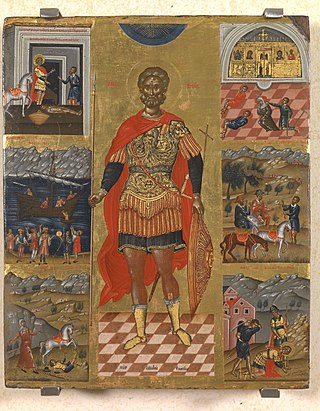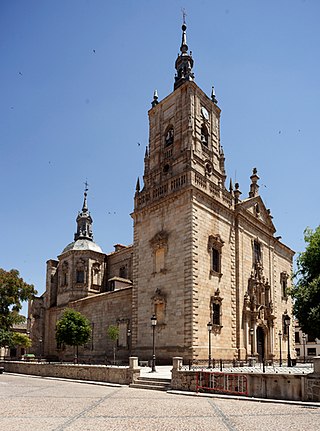
Toledo is a city and municipality of Spain, the capital of the province of Toledo and the de jure seat of the government and parliament of the autonomous community of Castilla–La Mancha.

Dominikos Theotokopoulos, most widely known as El Greco, was a Greek painter, sculptor and architect of the Spanish Renaissance. El Greco was a nickname, and the artist normally signed his paintings with his full birth name in Greek letters, often adding the word Κρής, which means "Cretan".

View of Toledo, is one of the two surviving landscapes painted by El Greco, along with View and Plan of Toledo. View of Toledo is held by the Metropolitan Museum of Art in New York City.

The Spanish Renaissance was a movement in Spain, emerging from the Italian Renaissance in Italy during the 14th century, that spread to Spain during the 15th and 16th centuries.

The Opening of the Fifth Seal was painted in the last years of El Greco's life for a side-altar of the church of Saint John the Baptist outside the walls of Toledo. Before 1908, El Greco's painting had been referred to as Profane Love. The scholar Manuel B. Cossio had doubts about the title and suggested the Opening of the Fifth Seal. The Metropolitan Museum, where the painting is kept, comments: "the picture is unfinished and much damaged and abraded."

The Burial of the Count of Orgaz is a 1586 painting by El Greco, a prominent Renaissance painter, sculptor, and architect of Greek origin. Widely considered among his finest works, it illustrates a popular local legend of his time. An exceptionally large painting, it is divided into two sections, heavenly above and terrestrial below, but it gives little impression of duality, since the upper and lower sections are brought together compositionally.
El Greco (1541–1614) was a prominent painter, sculptor and architect active during the Spanish Renaissance. He developed into an artist so unique that he belongs to no conventional school. His dramatic and expressionistic style was met with puzzlement by his contemporaries but gained newfound appreciation in the 20th century.

Dormition of the Virgin is a tempera painting on panel executed by El Greco near the end of his Cretan period, probably before 1567. El Greco's signature on the base of the central candelabrum was discovered in 1983. The discovery of the Dormition led to the attribution of three other signed works of "Doménicos" to El Greco and then to the acceptance as authentic of more works, signed or not.

The Assumption of the Virgin is an oil on canvas painting by Greek artist Doménikos Theotokópoulos, known as El Greco, in 1577–1579. The painting was a central element of the altarpiece of the church of Santo Domingo el Antiguo in Toledo, Spain. It was the first of nine paintings that El Greco was commissioned to paint for this church. The Assumption of the Virgin was El Greco's first work in Toledo and started his 37-year career there. Under the influence of Michelangelo, El Greco created a painting that in essence was Italian, with a naturalistic style, monumental figures, and a Roman school palette. The composition of El Greco's depiction of the Assumption of the Virgin resembles Titian's Assumption in the Basilica dei Frari in Venice with Virgin Mary and angels above and the apostles below. On the painting Virgin Mary floats upward which symbolizes her purity, while apostles gathered around her empty tomb express amazement and concern.

The Disrobing of Christ or El Expolio is a painting by El Greco begun in the summer of 1577 and completed in the spring of 1579 for the High Altar of the sacristy of the Cathedral of Toledo, where it still normally hangs. In late 2013 it was on temporary display at the Prado in Madrid, following a period of cleaning and conservation work there; it was returned to Toledo in 2014. It is one of El Greco's most famous works. A document dated July 2, 1577 which refers to this painting is the earliest record of El Greco's presence in Spain. The commission for the painting was secured thanks to El Greco's friendship from Rome with Luis, the son of Diego de Castilla, the dean of the Cathedral of Toledo. De Castilla senior also arranged El Greco's other major commission, on which he worked simultaneously, the paintings for the Toledan church of Santo Domingo el Antiguo.

Cretan School describes an important school of icon painting, under the umbrella of post-Byzantine art, which flourished while Crete was under Venetian rule during the Late Middle Ages, reaching its climax after the Fall of Constantinople, becoming the central force in Greek painting during the 15th, 16th and 17th centuries. The Cretan artists developed a particular style of painting under the influence of both Eastern and Western artistic traditions and movements; the most famous product of the school, El Greco, was the most successful of the many artists who tried to build a career in Western Europe, and also the one who left the Byzantine style farthest behind him in his later career.

El Greco, 1541 – April 7, 1614) was a prominent painter, sculptor and architect of the Spanish Renaissance, whose dramatic and expressionistic style was met with puzzlement by his contemporaries but found appreciation in the 20th century.

Orgaz is a municipality located in the province of Toledo, Castile-La Mancha, Spain. According to the 2012 census, the municipality had a population of 2804 inhabitants, but it has since declined.
In 1935, Spanish artist Pablo Picasso, 53, temporarily ceased painting, drawing, and sculpting in order to commit himself to writing poetry, having already been immersed in the literary sphere for years. Although he soon resumed work in his previous fields, Picasso continued in his literary endeavours and wrote hundreds of poems, concluding The Burial of the Count of Orgaz in 1959.

The Iglesia de Santo Tomé is a church located in the historical center of the city of Toledo (Spain), and was founded after the reconquest of this city by King Alfonso VI of León. It appears quoted in the 12th century, as constructed on the site of an old mosque of the 11th century. This mosque, together with other mosques in the city, were used as Christian churches without major changes, since in the taking of the city there was no destruction of buildings.

The El Greco Museum is located in Toledo, Spain. It celebrates the mannerist painter El Greco, who spent much of his life in Toledo, having been born in Fodele, Crete.

Saint Sebastian, or Martyrdom of Saint Sebastian is an autograph work by the famed artist Doménikos Theotokópoulos, commonly known as El Greco. It shows the Martyred Saint in an atypical kneeling posture which has led some scholars to believe it to be a compositional quotation of various works by other great masters whom the artist admired. The painting is currently on display in the Palencia Cathedral.

Portrait of Antonio de Covarrubias is a 1595-1600 oil on canvas painting by El Greco, dating to his time in Toledo. It is now in the Louvre in Paris as the result of an exchange with Spanish museums in 1941.

Christ Carrying the Cross is an oil painting by El Greco, produced early in his Toledo period circa de 1580. The picture depicts Christ in a moment of personal reflection as he carries the cross to his death, therefore committing the ultimate sacrifice for humankind. In the painting, Christ's eyes are lifted up to the heavens as he begins his walk towards his crucifixion. His gentle hands wrap around the cross as a stormy night floods the background. Christ Carrying the Cross is an oil painting, 105x79cm. The painting, one of numerous similar paintings by El Greco, is currently in the El Greco room in the New York art collection of the Metropolitan Museum of Art.

Allegory of the Camaldolese Order is a composition by El Greco and his workshop that survives in two paintings, one at the Instituto Valencia de Don Juan in Madrid and the other at the Museo del Patriarca in Valencia. The paintings depict a bird's-eye view of the "ideal monastery" according to the Camaldolese, and were likely commissioned as part of Fray Juan de Castañiza's petition to Philip II in 1597 to establish the benedictine monastic order in Spain.


















